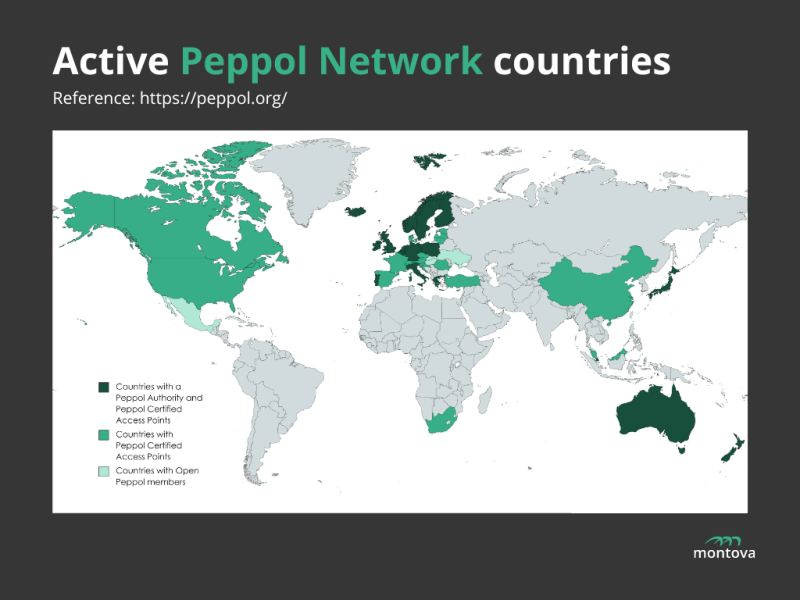E-invoicing
All about Peppol | Ultimate Guide
Peppol (Pan-European Public Procurement Online) has emerged as a game-changing framework for electronic document exchange. A vital component of this network is the involvement of certified service providers.
What is Peppol?
Peppol (Pan-European Public Procurement Online) is an international e-procurement network and interoperability framework designed to streamline electronic document exchange between businesses, particularly in the public sector.
It was initially established in 2008 and has since gained significant adoption across Europe and several other countries worldwide. The primary objective of Peppol is to simplify and standardize electronic procurement processes, allowing organizations to exchange various types of business documents electronically. This includes documents such as purchase orders, invoices, catalogs, and other procurement-related messages.
How does Peppol work?
Peppol Network Infrastructures
The Peppol network runs in distributed infrastructures that enable electronic document exchange between participants. There are infrastructures like Service Providers, Access Points, and Service Metadata Publishers (SMPs) that help the process smooth and secure. Let's understand each part of the stakeholders in the process of Peppol Network.
- Service Providers:
Service Providers are the organizations that provide services to participants (buyers and suppliers). Service providers act as intermediaries between participants and the Peppol Network, managing onboarding onto the Peppol network, providing technical solutions, and facilitating document exchange.*Montova is also one of the Certified Service Provider that assists in translating your document into the correct format, and provide Access Point.
- Access Points:
Access Points are the gateways that connect participants to the Peppol Network. Access Points manage the transmission, validation, and routing of electronic documents between participants. Access Points ensure that the exchanged documents comply with Peppol standards and technical requirements.
- SMPs (Service Metadata Publisher):
SMP is a directory that contains information about the participants and each Access Point. These directories allow participants to look up the routing information to deliver documents to their recipients.
- SMLs (Service Metadata Locators):
The primary function of the SML is to act as a centralized directory that maintains and provides information about the participants and their corresponding Access Points.
- Participants:
Senders and Recipients each have their own unique address in the Peppol Network called a "Peppol ID". To exchange electronic documents through the Peppol Network, it is required to register with a certified Peppol Access Point provider and get your own Peppol ID.
Peppol network process (flow)
*First, both parties (sender and recipient) must be onboarded in Peppol Network and have their own identifier (Peppol ID).

1. Document Preparation
Participants prepare electronic documents such as e-invoices, purchase orders, etc. in a standardized format that matches the requirements of Peppol specifications.
2. Document Exchange
Service Providers make sure of the structure and content of the documents to ensure compliance with the Peppol BIS (Business Interoperability Specifications) and other relevant standards. This validation helps prevent errors and discrepancies during document exchange. Then, Service Providers transmit the document to their connected Peppol Access Point (Sending Access Point).
3. Validate (at Sender's Access Point)
The sending Access Point validates the document's structure, ensuring that the document adheres to the Peppol standards and technical requirements. Once it passes validation, the sending Access Point encrypts and digitally signs the document before transmitting it to the Peppol network.
4. Identify the recipient and Transmission
Once the document passes validation, the sending Access Point routes it through the Peppol network to reach the intended recipient's Access Point. Those Peppol Network participants' addresses and details are stored in SML (Service Metadata Locator) and SMP (Service Metadata Publisher). If the recipient is identified, the document is transmitted to the recipient's Access Point as an encrypted document.
5. Deliver to the recipient
After successful validation, the recipient's Access Point delivers the document to the recipient's designated system or software. This could be an e-procurement system, invoicing software, or any other business application capable of handling Peppol documents.
6. Notify the sender of the delivery
The recipient's Access Point sends the exchange of acknowledgment messages back to the sending Access Point. Such as "Message Level Response" (MLR) and "Application Response" (AP) messages for confirming the successful receipt of the document.
Peppol - Formats, specifications
Peppol aims to streamline the procurement process and promote interoperability among different systems and countries. To achieve this, Peppol relies on specific protocols, specifications, formats, and standards.
Specifications: Peppol specifications define the rules and guidelines that participants must follow to ensure consistent data exchange. The main specifications include:
- Peppol BIS (Business Interoperability Specifications): These specifications define the standard formats for specific document types, like e-invoices, purchase orders, and credit notes. Peppol BIS ensures that the documents exchanged between different systems are structured uniformly, promoting interoperability.
- Peppol Transport Infrastructure Agreements (TIA): These agreements specify the technical requirements and rules for transport protocols like AS2, AS4, and SFTP. They cover details such as security mechanisms, message envelopes, and endpoint addresses.
Formats: Peppol supports several document formats for different types of business documents. The most common formats include:
- UBL (Universal Business Language): UBL is an XML-based format that defines a standard library of business documents, such as invoices, orders, and shipping notices. It is widely used in e-invoicing and electronic procurement.
- CII (Cross-Industry Invoice): CII is another XML-based format used for electronic invoicing. It is prevalent in European e-invoicing and is harmonized with the European Norm (EN) 16931 standard.
Overall, the combination of specific specifications, formats, etc ensures that the Peppol Network operates smoothly, enabling businesses and public entities to exchange documents electronically in a standardized and interoperable manner.
Countries that are using Peppol


Peppol has been widely adopted especially across Europe, with several countries mandating the use of Peppol for public sector procurement. It has also gained traction outside of Europe, with countries like Australia, New Zealand, Singapore, and Canada.
Here is a list of countries that have adopted the Peppol Network, allowing you to send e-invoices to them:
- Australia
- Austria
- Belgium
- Croatia
- Cyprus
- Denmark
- Estonia
- Finland
- France
- Germany
- Greece
- Iceland
- Ireland
- Italy
- Japan
- Latvia
- Lithuania
- Luxembourg
- Malaysia
- Malta
- Netherlands
- New Zealand
- Norway
- Poland
- Portugal
- Singapore
- Slovenia
- Spain
- Sweden
- Turkey
- United Kingdom
- and more
How can I join the Peppol Network?
To join the Peppol Network, your business need to start by partnering with a certified service provider. These providers guide the onboarding process, help with technical integration, and provide continuous support. By aligning your systems with Peppol standards and utilizing the secure network infrastructure, your organization can achieve smooth and efficient document exchange.
Why Peppol Network is recognized

Peppol offers several benefits to businesses, government organizations, and other participants in the electronic document exchange ecosystem.
The key benefit of Peppol Network is "Interoperability". You can facilitate cross-border e-procurement, adhering to the Peppol framework and specifications. Organizations can connect with partners in different countries without the need for complex integrations or individual bilateral agreements. This interoperability improves and benefits business efficiency, governance, cost savings, and governance.
Here are the other advantages:
- Efficiency in facilitating cross-border
Initially, Peppol was developed as an EU standard, however, globally Peppol has spread to other regions, enabling global connectivity for businesses. This expanded reach allows companies to easily engage in cross-border trade and collaborate with partners worldwide. - Global reach (benefits of network)
The onboarding process is simple and fast without needing any end-to-end testing. Once your business joins the Peppol network, you gain access to a wide range of potential trading partners immediately, without having to negotiate separate terms and conditions with each one. - Easy Document communication
The standardizing document formats using structured data formats in Peppol ensures that the information exchanged between trading partners is consistent and aligned. Not only that, Peppol's validation processes eliminate errors and help stabilize business relationships from misunderstanding. - High security
Peppol is strict with data security, they use encryption and digital signatures, to protect the confidentiality and integrity of the transmitted documents. This level of security builds trust among participants and safeguards sensitive information. - Transparency and governance
Peppol supports compliant e-invoicing, making it easier for businesses to meet the invoicing requirements of various governments and public sector entities. This is particularly important when dealing with public procurement contracts. Plus, Peppol keeps an audit trail for all transactions conducted on the platform. It is clear and traceable which ensures accountability and facilitates easy tracking of documents and their status. - Cost saving
Adopting Peppol can lead to cost savings for businesses and government agencies. It reduces the need for paper-based processes, manual data entry, and physical document handling, which can be time-consuming and expensive.
Are you looking for a certified Peppol Service Provider?
Montova is one of the certified Peppol Service Providers. We have our own unique platform, that offers the most efficient and productive working process.
If you want to hear more about us, request an inquiry to Montova.


